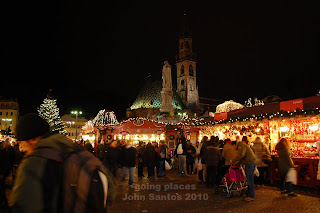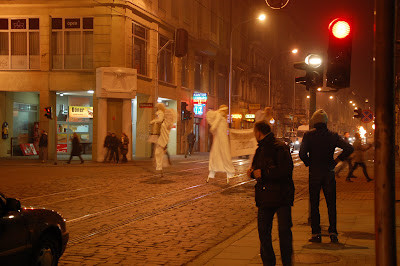In Warsaw for four days and with a newfound liking for beer, I made tasting Polish beers one of the goals of my trip. Although not as well-known as the Czech Republic for beer, the Polish love their beers: they are the third largest producer in the continent and the seventh largest consumer of it in the world. But the vast majority of the beers in the country is produced by three large conglomerates (what else, SABMiller/Tyskie, Heineken/Zywiec and Carlsberg/Okocim), and their beers all roughly taste the same (bland with a high dose of carbonation, like other American lagers). Although recent introduction of craft beers from overseas has prompted these big companies to start producing different types of beers, from my experience the divergence largely results in failure. The Baltic porters from Zywiec and Okocim for example were too harsh, with I'm guessing the brewers adding adjuncts to bump up the alcohol content artificially. (Surprisingly enough, Zywiec porter gets good revies online; I guess in relation to what I had, it was really awful.) Anyway, beyond the ubiquitous Tyskie/Zywiec/Okocim beers on tap pretty everywhere in Warsaw, there were some interesting beers--at least for me, who never really had much on experience with beer other than the German/Belgian/Czech style beers popular in this side of Europe and in the US. These beers were not very easy to find--regional Polish beers, unlike regional beers elsewhere, rarely venture too far away from their place of origin--but offered a diverse array of flavors that are worthy of being sought.

Brewpubs are not very popular in Poland, and in Warsaw one can only find two: Browarmia and Bierhalle, both found along Nowy Swiat. Bierhalle is a chain restaurant found across the country specializing in Bavarian cuisine and beer. Their waitresses wear drindls, they serve hefeweizen in winter, and serve little German sausages and pork knuckles. The beers, although produced on site, are nothing special, surely appealing to a wide range of taste. Browarmia on the other hand is worth seeking, serving more distinctive beers and food. Their seasonal cherry beer is good, more tart like a cherry geuze beer than sweet like a Lindemanns. The arome is of hops and cherry blossoms. Their porter is also very good, defined by its robust smoky coffee flavors and aroma and really smooth finish.
Beyond these two places, there really is a major dearth of beers on draught in Warsaw. Even in the best pubs around the university area, beers on tap usually consist of variations of the big three. In this case, one is required to venture out into the rest of the city in search of bottled beer. This proves to be not so difficult. The city is littered with "alkohole" or liquor stores. Unlike liquor stores in the US, these tend to be less sketchy and more upmarket, offering beers from the cheapest/skunkiest to the premiums. Out of these, I picked a handful that the person behind the counter suggested.

Jagiello Magnus is a 6% chocolate-flavored porter produced by Jagiello in Pokrowka, 80km from Lublin. Upon opening, the sweet, milk chocolate aroma immediately hits, almost like Hershey syrup. In a glass, the beer's brownish head is moderate with a clear, dark brown color. The body is appropriately nice and creamy. The taste is not as sweet as I expected. Now, don't get me wrong: it is sweet. But it's not so cloying, and the mellow carbonation and the lasting raw cocoa bitterness cuts through the sweetness. I love chocolate milk and I became tipsy too quickly due to drinking this a little too fast.

Next up is Perla Czarna Extra Strong from Lublin. At 8%, it is the newest and strongest of Perla's generally highly-renowned line of beers. The aroma is hoppy and a bit savory. There is a bit of tartness on the flavor and a hint of sweetness, and finishes with a somewhat chemical and spicy bitterness. The beer is decent, but nothing special.

Unlike the Perla Czarna, Ciechan Porter was an absolute discovery, and what I imagine a proper Baltic porter should taste like. Brewed in Ciechanow about 100km northwest of Warsaw, the porter pours a very dark brown, producing a thick, creammy, brown head that lingers throught the entire session. The aroma is robust and dare I say muscular, with hints of dark roasted coffee, hazelnuts, dark syrup, and smoked wood. The coffee continues with the taste, with the dominating espresso flavor backed up by a slight sweetness and nuttiness. A coffee bitterness lasts throughout and finishes with a mellow and pleasant aftertaste. Unlike the relative innocence of the Jagiello which hides its alcohol well, you can feel the 9% hit, but such an aggresive beer would have otherwise been pointless without it. Probably the best beer I had in Poland, and one of the best anywhere.

Hands down the most distinct beer I've had anywhere, Piwo Miodne is a product of Browar Kormoran in Osztyn. Honey or honey flavored beer is a fairly common product in Poland, but this is the only one I had. To be honest, I don't really know what to think about this beer. It is a complex beer surely, but I wonder if it is a little too complex. When pouring, it looks like soda that lost its fizz: almost still, no head, dark mahogany color, with no traces of cloudiness. The scent is different gradiation of sugar: floral, honey, candy, perfume, all alternating. While tasting it, I imagined that this was how drinking perfume might be like: combinations of fruits and flowers all doused in a liberal serving of honey. The 5.7% ABV is not aparent at all. It's not too sweet, but one would not miss the honey. I think I will be seeking this upon return to Poland, just to see if I would still be ambivalent to it the second time around.

Although I previously mentioned that beer produced by the large breweries are generally not worth the attention, they do have one very good use: making piwo grzane. In Italy, most everyone is familiar with mulled wine especially during the holidays, but piwo grzane is more than worthy of being considered an alternate. Basically, beer is boiled with spices, lemon, orange, and honey to produce a sweet, spicy, and warm concoction perfect for cold Polish winters. I think piwo grzane is best if the beer doesn't assert itself too much. In essence, it's just a vessel for delivering the tangy flavors created by the added spices. The name brand beers are perfect for their cheap price and relative tastelessness. Although it seems like sacrilege, it is more than worth the try.

If messing with beer isn't your thing, there are brewers such as Koreb that produce spiced beer--in this case, Herbowe--that are served heated by the brewery in Christmas markets. The flavors are more subtle, but the cheeriness of such flavors are definitely still there.














































